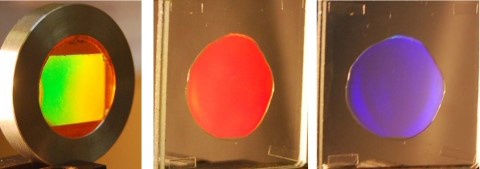
INFN Frascati National Laboratories (LNF), in collaboration with the National Academy of Science of Kiev and the Lviv Polytechnic in Ukraine and with the Fraunhofer Institute of Potsdam-Golm in Germany, proposed developing effective photonic crystal (PC) structures, made by a distribution of nanoparticles (NP) in polymer matrix for PC powered sensor applications and fluorescent and Raman spectroscopy.
In the last years the expertise in nanotechnology of the LNF NEXT group – that has been committed in the field of carbon nanostructured materials for electronic applications [1] since decades – made it possible to achieve recognitions for DNA bio-sensors design and for the application of high-tech devices based on innovative materials, such as carbon nanotubes and the first stable two-dimensional material with exceptional properties, i.e. graphene, in biological, medical and environmental fields.
The new project Nanocomposite based photonic crystal sensors of biological and chemical agents, directed by Stefano Bellucci – scientific responsible for INFN in the Graphene Flagship project of the European Commission, and founder and leader of the NEXT group – is financed by NATO in the frame of the Science for Peace programme. It aims at building prototypes of PC structures, designed for fast, non-destructive detection of very small amounts (of the order of 100 femtograms, down to even single molecules) of biological and chemical toxins and to monitor with high-sensitivity environmental pollution caused by biological and chemical agents.
The project suggests a new approach based on the deposition of special recognition layers, such as graphene nano-flakes and rare earth oxides, on the PC surface to detect the various agents chemically related to the recognition layer. Unlike resonant textured structures which are widely used nowadays – we propose using PC resonant structures for waveguides with periodic modulation of the permittivity.
The PC structures in photosensitive nanocomposites will be realized by holographic lithography.
We will use original photopolymer nanocomposites, developed by German and Ukrainian research teams participating in the Project and that include NP of different nature, as you can see in Figure 1. PC structures are formed by diffusion redistribution of the NP, such as graphene nano-flakes, in the polymer matrix during exposure to an interference pattern. The periodic structure and its thickness, as well as the refractive index of the material can be varied in such a way that the structure can support guided-mode resonances at designated wavelength region.
[1] S. Bellucci, Carbon nanotubes: physics and applications, Physica Status Solidi C, Volume 2, Gennaio 2005, Pagg. 34–47
Translation by Camilla Paola Maglione, Communications Office INFN-LNF
 INFN-LNF Laboratori Nazionali di Frascati
INFN-LNF Laboratori Nazionali di Frascati